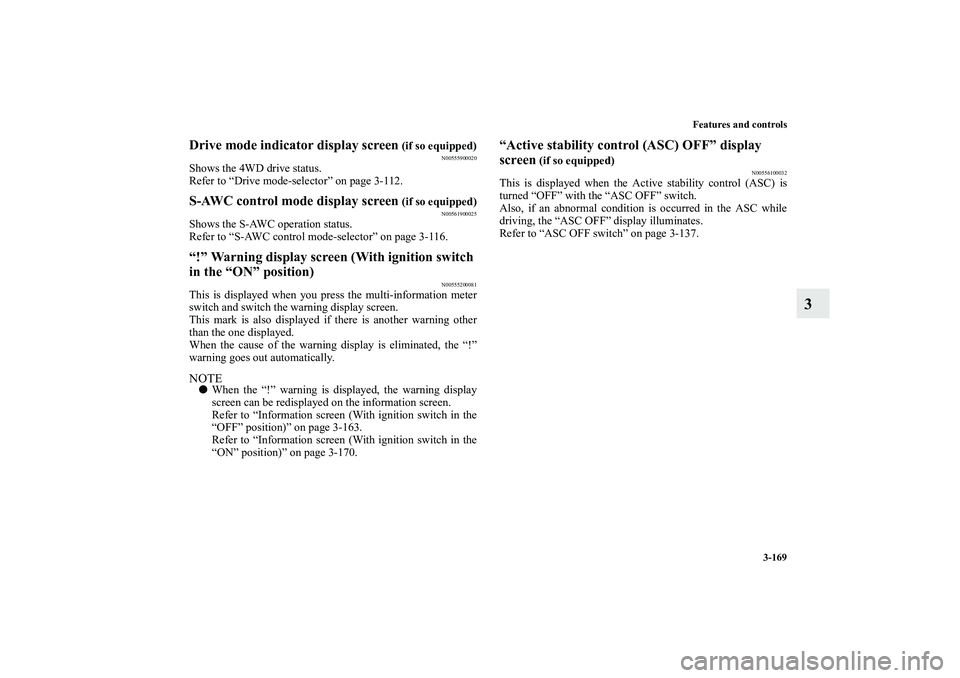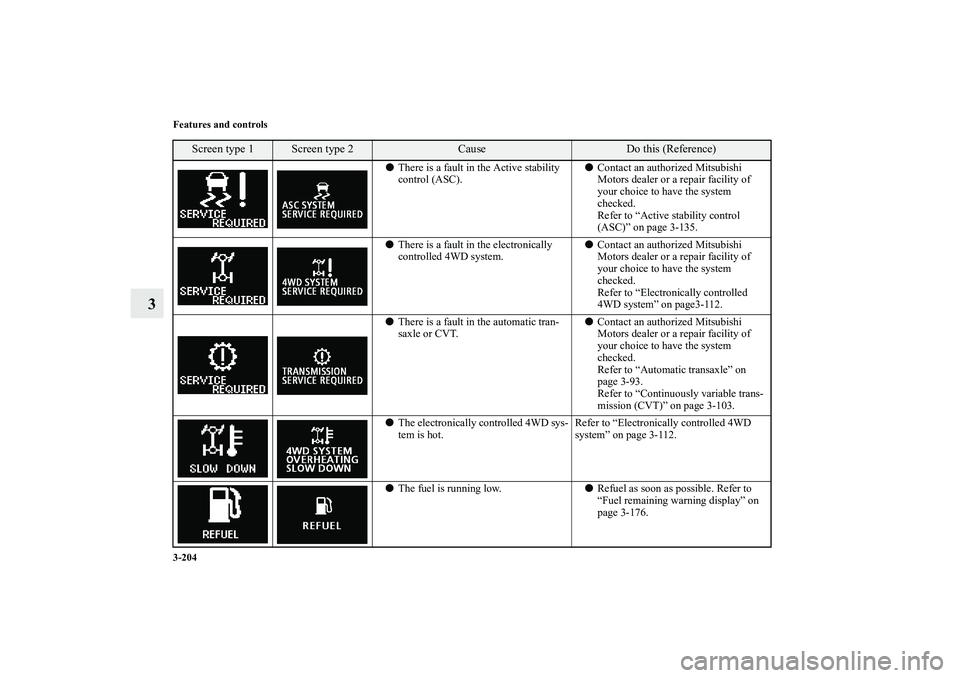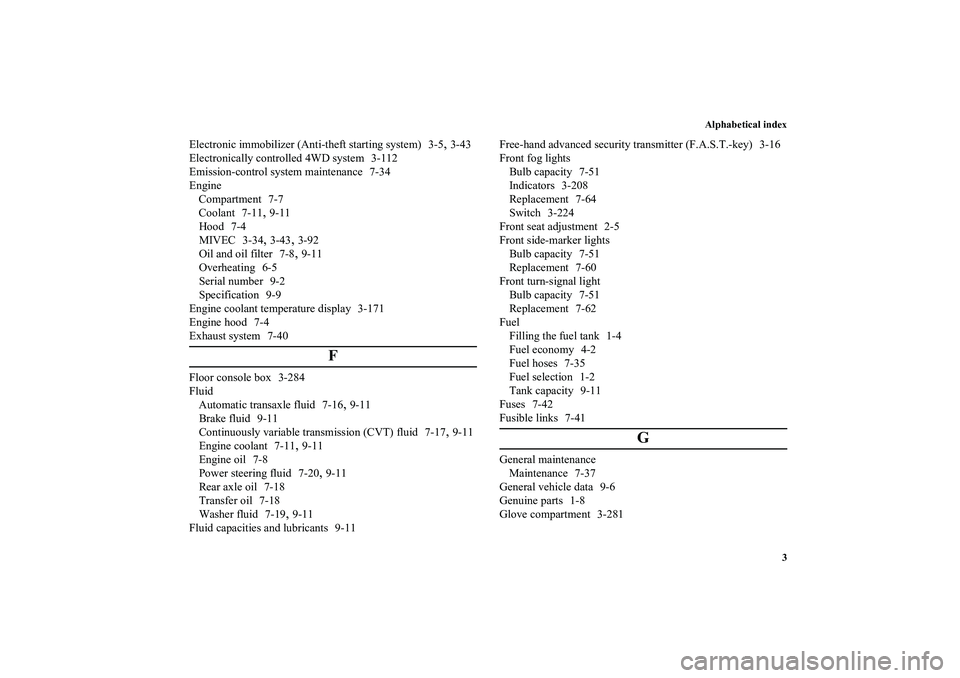Page 280 of 714

Features and controls
3-169
3
Drive mode indicator display screen
(if so equipped)
N00555900020
Shows the 4WD drive status.
Refer to “Drive mode-selector” on page 3-112.S-AWC control mode display screen
(if so equipped)
N00561900025
Shows the S-AWC operation status.
Refer to “S-AWC control mode-selector” on page 3-116.“!” Warning display screen (With ignition switch
in the “ON” position)
N00555200081
This is displayed when you press the multi-information meter
switch and switch the warning display screen.
This mark is also displayed if there is another warning other
than the one displayed.
When the cause of the warning display is eliminated, the “!”
warning goes out automatically.NOTE�
When the “!” warning is displayed, the warning display
screen can be redisplayed on the information screen.
Refer to “Information screen (With ignition switch in the
“OFF” position)” on page 3-163.
Refer to “Information screen (With ignition switch in the
“ON” position)” on page 3-170.
“Active stability control (ASC) OFF” display
screen
(if so equipped)
N00556100032
This is displayed when the Active stability control (ASC) is
turned “OFF” with the “ASC OFF” switch.
Also, if an abnormal condition is occurred in the ASC while
driving, the “ASC OFF” display illuminates.
Refer to “ASC OFF switch” on page 3-137.
BK0115300US.book 169 ページ 2009年7月16日 木曜日 午前9時13分
Page 315 of 714

3-204 Features and controls
3
�There is a fault in the Active stability
control (ASC).�Contact an authorized Mitsubishi
Motors dealer or a repair facility of
your choice to have the system
checked.
Refer to “Active stability control
(ASC)” on page 3-135.
�There is a fault in the electronically
controlled 4WD system.�Contact an authorized Mitsubishi
Motors dealer or a repair facility of
your choice to have the system
checked.
Refer to “Electronically controlled
4WD system” on page3-112.
�There is a fault in the automatic tran-
saxle or CVT.�Contact an authorized Mitsubishi
Motors dealer or a repair facility of
your choice to have the system
checked.
Refer to “Automatic transaxle” on
page 3-93.
Refer to “Continuously variable trans-
mission (CVT)” on page 3-103.
�The electronically controlled 4WD sys-
tem is hot.Refer to “Electronically controlled 4WD
system” on page 3-112.
�The fuel is running low.�Refuel as soon as possible. Refer to
“Fuel remaining warning display” on
page 3-176.
Screen type 1
Screen type 2
Cause
Do this (Reference)
BK0115300US.book 204 ページ 2009年7月16日 木曜日 午前9時13分
Page 317 of 714
3-206 Features and controls
3
Other interrupt displays (With ignition switch in the “ON” position)
N00558200154
The operation status of each system is displayed on the information screen. For further details, refer to the appropriate page for each
system.
Screen type 1
Screen type 2
System operation status
Reference
�When “2WD” drive mode is selected
with the drive mode selector.Refer to “Electronically controlled 4WD
system” on page 3-112.
�When “4WD AUTO” mode is selected
with the drive mode selector.
�When “4WD LOCK” mode is selected
with the drive mode selector.
�When the Active stability control
(ASC) is operating.Refer to “Active stability control (ASC) ” on
page 3-135.
BK0115300US.book 206 ページ 2009年7月16日 木曜日 午前9時13分
Page 407 of 714

4-2 Driving safety
4Driving precaution
N00629300053
Utility vehicles have higher ground clearance and a narrower
track, which enables them to perform in a wide variety of off-
road situations. Because of the higher ground clearance, these
vehicles have a higher center of gravity, which makes them
handle differently than ordinary vehicles when driving on
pavement. They are not designed to maneuver or corner at the
same speed on pavement as conventional 2-wheel drive pas-
senger cars any more than low-slung sports cars are designed
to perform satisfactorily in off-road conditions.
Always drive safely and steer the vehicle carefully. Avoid oper-
ating the vehicle in a manner that might require sharp turns or
abrupt maneuvers. As with other vehicles of this type, failure
to operate this vehicle correctly can result in loss of control or
vehicle rollover.
In a rollover crash, an unbelted person is significantly more
likely to die than a person wearing a seat belt. Before starting
the vehicle, always make certain that you and all your passen-
gers are properly wearing their seat belts (with children in the
rear seat, in appropriate restraints).
Fuel economy
N00628800149
Fuel economy is dependent on many factors. Your personal
driving habits can have a significant effect on your fuel use.
Several recommendations for achieving the greatest fuel econ-
omy are listed below.�
Whenever accelerating from a stop, always accelerate
slowly and smoothly.
�
When parked for even a short period, do not idle the
engine. Shut it off.
�
Plan your trips to avoid unnecessary stops.
�
Keep your tires inflated to the recommended pressures.
�
When you drive on highways or dry improved roads, set
the drive mode-selector “2WD”, “4WD AUTO” or “TAR-
MAC” position (if so equipped).
�
For freeway driving, maintain a speed of approximately
50 mph (80 km/h) when traffic, roadway and weather con-
ditions safely permit.
�
Keep your air filter clean and your vehicle lubricated
according to the recommendations in this manual.
�
Always keep your vehicle well maintained. A poorly
maintained engine wastes fuel and costs money.
�
Never overload your vehicle.
WA R N I N G
!�
Utility vehicles have a significantly higher rollover
rate than other types of vehicles. Avoid abrupt
maneuvers and excessive speed. Always buckle up.
BK0115300US.book 2 ページ 2009年7月16日 木曜日 午前9時13分
Page 706 of 714

Alphabetical index
3
Electronic immobilizer (Anti-theft starting system) 3-5
,3-43
Electronically controlled 4WD system 3-112
Emission-control system maintenance 7-34
Engine
Compartment 7-7
Coolant 7-11
,9-11
Hood 7-4
MIVEC 3-34,3-43
,3-92
Oil and oil filter 7-8,9-11
Overheating 6-5
Serial number 9-2
Specification 9-9
Engine coolant temperature display 3-171
Engine hood 7-4
Exhaust system 7-40
F
Floor console box 3-284
Fluid
Automatic transaxle fluid 7-16
,9-11
Brake fluid 9-11
Continuously variable transmission (CVT) fluid 7-17
,9-11
Engine coolant 7-11
,9-11
Engine oil 7-8
Power steering fluid 7-20
,9-11
Rear axle oil 7-18
Transfer oil 7-18
Washer fluid 7-19
,9-11
Fluid capacities and lubricants 9-11Free-hand advanced security transmitter (F.A.S.T.-key) 3-16
Front fog lights
Bulb capacity 7-51
Indicators 3-208
Replacement 7-64
Switch 3-224
Front seat adjustment 2-5
Front side-marker lights
Bulb capacity 7-51
Replacement 7-60
Front turn-signal light
Bulb capacity 7-51
Replacement 7-62
Fuel
Filling the fuel tank 1-4
Fuel economy 4-2
Fuel hoses 7-35
Fuel selection 1-2
Tank capacity 9-11
Fuses 7-42
Fusible links 7-41
G
General maintenance
Maintenance 7-37
General vehicle data 9-6
Genuine parts 1-8
Glove compartment 3-281
BK0115300US.book 3 ページ 2009年7月16日 木曜日 午前9時13分